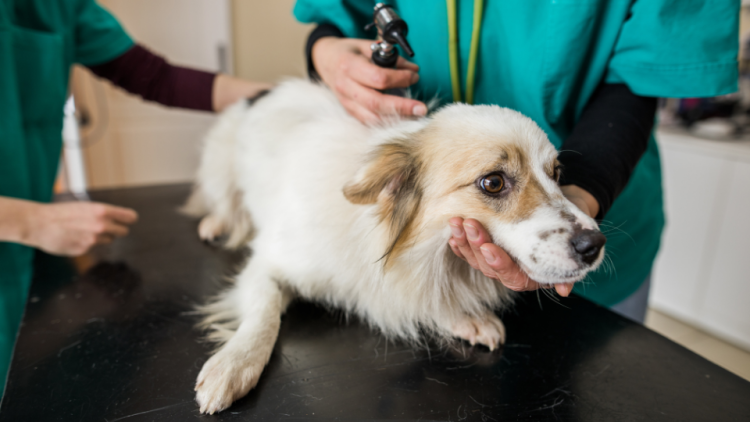Is your dog stumbling, staggering, or falling over more often than usual? If so, the loss of balance may be due to a medical condition known as ataxia. Ataxia is a condition relating to a sensory dysfunction that results in a loss of coordination. It is a severe health problem that requires immediate veterinary attention.
Keep reading to learn more about this condition so you can better recognize the ataxia symptoms in dogs if they occur.
Table of Contents:
- What is ataxia?
- Causes of ataxia in dogs
- Symptoms of ataxia in dogs
- Diagnosing ataxia in dogs
- Treatment of ataxia in dogs
- Key Takeaways
Pro Tip: If the condition does not exist at the time of enrollment, the cost to treat dog ataxia may be covered by your pet insurance policy.
What is ataxia?
The term ataxia refers to incoordination within the nervous system. It can occur in the head, limbs, torso, rear end, or all four legs. There are three types of ataxia in dogs, depending on the location of the abnormality:
Proprioceptive ataxia
Proprioception occurs when the animal's nervous system has trouble identifying the location of its limbs. It's often characterized by loss of balance, stumbling, swaying, dragging the limbs between steps, and falling to the ground. Proprioceptive ataxia is usually the result of pressure on the spinal cord, often caused by a tumor, bulging intervertebral disk, or a bleeding vessel inside the spinal cord.
Cerebellar ataxia
Dogs that have exaggerated limb movements and head tremors might have an impairment in the cerebellum, the region of the brain responsible for fine motor movements. Cerebellar ataxia in dogs is usually due to congenital defects, inflammatory diseases, or brain tumors.
Vestibular ataxia
Vestibular ataxia refers to an issue in the inner ear that affects the canine's perception of their body position and movement. Also called vestibular syndrome or vestibular abnormality, this condition disrupts the dog's balance and makes them feel dizzy, often seen as a head tilt due to unbalanced equilibrium.

Causes of ataxia in dogs
Ataxia is always a symptom of an underlying illness or injury. There are many conditions that can cause ataxia, including:
- Trauma to the head or spinal cord
- Tumors in the nervous system
- Inflammation of the brain or brain stem
- Infections affecting the brain, such as distemper virus
- Infection of the spinal disks or vertebrae
- Infections of the inner or middle ear
- Vestibular disease
- Heart disease
- Red blood cell count abnormalities
- Blood circulation issues
- Respiratory disease
- Hypothyroidism
- Thiamine deficiency
- Electrolyte imbalances
- Low levels of potassium, calcium, or glucose
- Medication overdose
- Congenital abnormalities (known as hereditary ataxia) that dogs are born with
Without immediate treatment, many of these conditions can cause permanent damage. It’s always better to be safe than sorry and seek medical treatment if you notice signs of concern in your dog.
Symptoms of ataxia in dogs
The most common clinical signs of canine ataxia include:
- Weakness in one or more limbs
- Dragging the feet when walking
- Crossing the legs when walking
- Exaggerated limb movements
- Swayed gait
- Difficulty maintaining balance
- Stumbling and/or falling
- Wide-based stance
- Wobbling or dizziness
- Tremors
- Unusual eye movements
- Excessive head tilting
- Loss of hearing
- Drowsiness, dizziness
- Nausea
- Loss of appetite
Ataxia can come on gradually or appear suddenly, depending on the underlying cause. The symptoms might be more visible in some dogs and milder in others. In some cases, the condition can be progressive and get worse over time.
If you notice any of the clinical signs of ataxia in dogs, be sure to see your veterinarian immediately.
Diagnosing ataxia in dogs
Your vet will probably start by asking you about your pet’s health history, the onset of clinical signs, and any incidents that may have preceded the condition. Then, the vet will perform a physical exam that includes palpitation of the animal's limbs and spine while listening to their lungs and heart. To determine the underlying cause of the dog's ataxia, they may decide to perform a neurologic exam and evaluate their gait, posture, and reflexes.
Diagnostic testing is essential for determining whether the ataxia affects the brain, the spinal cord, or the peripheral vestibular system that maintains balance. Standard tests include blood work, urinalysis, and an electrolyte panel. Depending on the symptoms, your veterinarian might also recommend:
- X-rays to check for cancer and systemic infection
- Abdominal ultrasound to check kidney, liver, and pancreatic functions
- Cerebrospinal fluid (CSF) sample for lab analysis
- MRI or CT scan in more severe cases

Treatment for ataxia in dogs
The ataxia treatment recommended for dogs varies depending on the cause and location of the nervous system disorder. If the underlying problem is due to infection or inflammation, the ataxia may be treatable with medication prescribed by a vet. Dogs may require supplemental nutrition to offset potential deficiencies in vitamin B, potassium, calcium, and glucose. In cases of severe infection or toxin ingestion, the dog may require hospitalization to receive more intensive care. Treatments for canine ataxia caused by tumors and cancer usually involve chemotherapy, radiation therapy, and surgery if necessary.
Pro Tip: There's a long list of potential causes for ataxia in dogs, so it's difficult to estimate the condition's cost of treatment. Some cases might require advanced diagnostics and a specialist's opinion, significantly increasing the total bill. If you're enrolled in a pet insurance plan, your provider may be able to help by reimbursing a portion of vet costs paid out-of-pocket.
Prognosis and recovery
Some dogs may not recover their lost balance or coordination following treatment for ataxia, but most can lead normal lives. It's important to make the environment safer by blocking off places where your pet could bump into sharp corners or fall and hurt themselves.
Pain management and supportive care may be necessary to improve the dog's quality of life. If your dog is diagnosed with ataxia, you should schedule regular checkups with your veterinarian to monitor your dog's progress in recovery.
Unfortunately, some underlying causes, such as hereditary ataxia, can't be cured. In many of these cases, dogs experience a nervous system degeneration, leading to a worsening of symptoms as the condition progresses. Once pet parents can no longer provide their loved one with a good quality of life, some may consider euthanasia with a veterinarian.
Talk to your vet about all your treatment options and the necessary lifestyle changes if your dog has ataxia.
Can you prevent ataxia in dogs?
Unfortunately, there's no definitive way to ensure that your dog will never suffer from ataxia, but positive wellness habits and routine care can help prevent some underlying causes.
For example, you could avoid ear infections with consistent cleaning, and minimize the risk of accidental poisoning by keeping household chemicals and prescription drugs out of reach. Additionally, making sure your dog is up-to-date with their vaccines, eats a healthy diet, and gets enough physical exercise can help prevent some of the causes of ataxia in dogs.
Key Takeaways
- Ataxia is a term that describes a lack of coordination caused by a problem in your pup’s nervous system. Ataxia is always a symptom of an underlying illness or injury.
- Common clinical signs of ataxia include a swaying gait, staggering, head tilting, falling, and more.
- The treatment program will depend on the location and cause of ataxia.
- If you notice any signs of ataxia, be sure to have your dog checked by a veterinarian right away.
